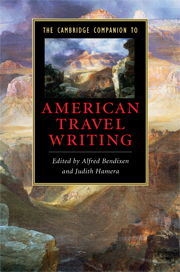Book contents
- Frontmatter
- Introduction: new worlds and old lands - the travel book and the construction of American identity
- Part I Confronting the American landscape
- 1 Beginnings: the origins of American travel writing in the pre-revolutionary period
- 2 “Property in the horizon”: landscape and American travel writing
- 3 New York to Niagara by way of the Hudson and the Erie
- 4 The Mississippi River as site and symbol
- 5 The Southwest and travel writing
- Part II Americans abroad
- Part III Social scenes and American sites
- Chronology
- Further Reading
- Index
1 - Beginnings: the origins of American travel writing in the pre-revolutionary period
from Part I - Confronting the American landscape
Published online by Cambridge University Press: 28 March 2009
- Frontmatter
- Introduction: new worlds and old lands - the travel book and the construction of American identity
- Part I Confronting the American landscape
- 1 Beginnings: the origins of American travel writing in the pre-revolutionary period
- 2 “Property in the horizon”: landscape and American travel writing
- 3 New York to Niagara by way of the Hudson and the Erie
- 4 The Mississippi River as site and symbol
- 5 The Southwest and travel writing
- Part II Americans abroad
- Part III Social scenes and American sites
- Chronology
- Further Reading
- Index
Summary
In eighteenth-century British America travel writing was not really an identifiable literary genre. Rather, the discourses of travel permeated all sorts of genres and writings that included a wide array of audiences and intentions. While some of these early travel writings actually do resemble modern travel narratives, most took shape in the context of other kinds of concerns: scientific, political, or religious. Travel writing, for example, sometimes involved mapping America for transatlantic readers interested in settling the frontier, especially in the aftermath of the British victory over France in the Seven Years War (1756-63). Or, alternatively, it involved the religious itinerant traveling simultaneously across spiritual and actual landscapes. Colonial American travel writing thus took shape in the context of other genres like nature writing, promotional writing about settling the American frontier, spiritual autobiography, and military history. This writing included poetic forms as well. Early eighteenth-century poets in British America adapted well-established English literary traditions such as pastoral and satire because they had cultural legitimacy. Both prose and poetic accounts of travel remind us that these accounts of American places often were written and published for metropolitan readers with particular (or potential) interests in North America. One of the earliest forms of travel literature is the promotional writing meant to attract emigrants and funding for British colonies. Probably the most notable instance of this kind of promotional writing was William Penn's “Some Account of the Province of Pennsylvania in America” (1681), which aimed to sell English migrants and capitalists on the future of his new colony.
- Type
- Chapter
- Information
- The Cambridge Companion to American Travel Writing , pp. 13 - 25Publisher: Cambridge University PressPrint publication year: 2009

